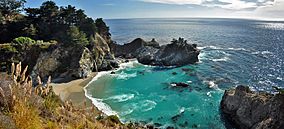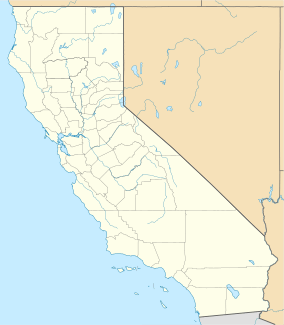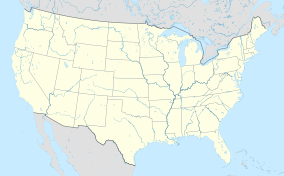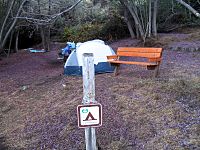Julia Pfeiffer Burns State Park facts for kids
Quick facts for kids Julia Pfeiffer Burns State Park |
|
|---|---|
|
IUCN Category III (Natural Monument)
|
|

The park's McWay Cove with McWay Falls
|
|
| Location | Monterey County, California, USA |
| Nearest city | Carmel-by-the-Sea, California |
| Area | 3,762 acres (1,522 ha) |
| Established | 1962 |
| Governing body | California Department of Parks and Recreation |
Julia Pfeiffer Burns State Park is a beautiful state park in California. It's located about 12 miles south of Pfeiffer Big Sur State Park along California's Pacific coast. One of the most famous sights here is McWay Falls. This waterfall drops about 80 feet (24 meters) right onto the beach or into the Pacific Ocean during high tide!
The park is also home to giant redwood trees. Some of these amazing trees are 300 feet (91 meters) tall and over 2,500 years old. The park is named after Julia Pfeiffer Burns. She was a well-known rancher who lived in the Big Sur area in the early 1900s. The park, which covers 3,762 acres (1,522 hectares), was created in 1962.
Contents
Discovering Julia Pfeiffer Burns State Park
Park's Early Days
The land that is now Julia Pfeiffer Burns State Park has a rich history. In the late 1870s, Christopher and Rachel McWay were among the first settlers to claim land here. Later, in 1924, a former U.S. Representative named Lathrop Brown and his wife Hélène bought the ranch from the McWays.
Julia Pfeiffer Burns was the daughter of the first European settlers in Big Sur. She married John Burns in 1914. Julia and her husband leased land from the Browns. Hélène Brown and Julia became close friends. Julia lived in the area for most of her life until she passed away in 1928.
The Waterfall House
The Browns first built a simple redwood cabin on the cliffs near McWay Falls. In 1940, they replaced it with a fancy two-story house called Waterfall House. This home had beautiful decorations and classic paintings inside.
During the building of the Carmel San Simeon Highway (from 1919 to 1937), the ranch foreman, Hans Ewoldsen, created something special. He built a Pelton wheel using redwood from the canyon. This wheel was installed on McWay Creek in 1932. It was the first way to get electricity in the Big Sur area! It powered three homes, a workshop, and even a small railway.
The Tin House Mystery
In 1944, during World War II, the Browns decided to build another house. They chose a spot high on a ridge, about three miles inland. Because building materials were hard to get during the war, they had to be creative.
The Browns bought parts from two old, abandoned gas stations. They hired a crew to carry these metal pieces up a steep road to the building site. An architect then designed a unique home using these parts.
The finished house looked very modern. It had a kitchen, living room, and even rooms for a maid. The family called it the Gas Station, but it later became known as the Tin House. From the living room, you could see amazing views up and down the coast.
However, the Browns only spent one night in their new house. They didn't realize that the metal walls and roof would make loud popping and creaking noises as they expanded and shrunk with the changing temperatures. After a sleepless night, they never returned!
A Gift to California
In 1956, Lathrop and Hélène Brown moved to Florida. After Lathrop passed away in 1959, Hélène decided to donate their entire property to the state of California in 1961. She wanted it to be a park and asked that it be named after her good friend, Julia Pfeiffer Burns.
Hélène also asked that the Waterfall House be turned into a museum. This museum would show Native American artifacts, local plants and animals, and historical items from the Big Sur area. However, the museum was never completed. Because of this, the mansion was taken down in 1965, as required by the gift's rules.
Fun Things to Do in the Park
Julia Pfeiffer Burns State Park offers some great ways to enjoy nature. It has two special hike-in camping areas. Sunset magazine even called them some of the "four best places to pitch a tent on the Pacific Coast." These campsites have amazing views of the Pacific Ocean. You need a reservation to camp there.
The Julia Pfeiffer Burns Underwater Area is a popular spot for scuba diving. It's a fantastic place to explore ocean life.
In 2008, wildfires burned parts of the park, but they stopped at Highway 1. The camping sites were safe. In 2009, many non-native acacia trees were removed from around the campsites. This was done to help bring back plants that naturally grow along the Big Sur Coast. New native plants and trees were then planted.
In 2007, a group called Mano Seca put a bench at Campsite #2. It's a perfect spot to sit and look out at the Pacific Ocean below.
You can also hike to the famous Tin House. One way is the Tanbark Trail, which is about 7 miles (11 kilometers) round trip. It climbs about 2,000 feet (610 meters). The other way is a shorter, steeper road that was used to build the house.
Protecting Ocean Life
Just offshore from Julia Pfeiffer Burns State Park are special places called Big Creek State Marine Reserve and Big Creek State Marine Conservation Area. These are like underwater parks. They help protect ocean animals and their homes, keeping the marine ecosystems healthy.
Images for kids






